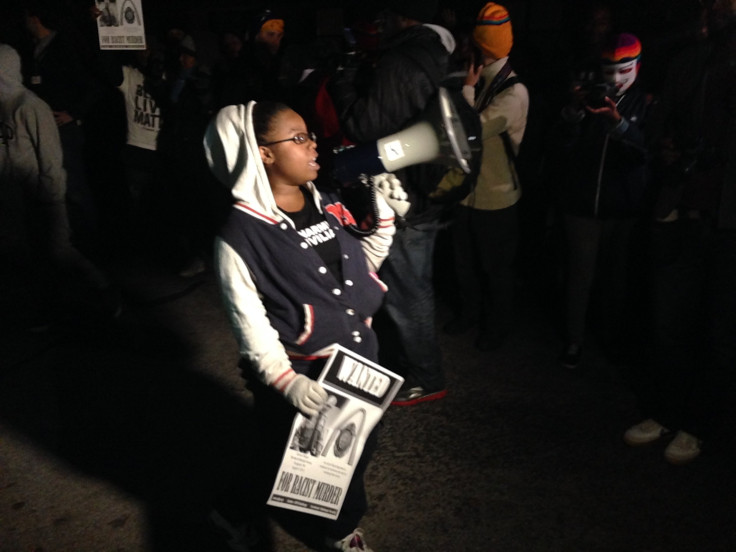Ferguson October Protest: Lesley McSpadden, Mother Of Mike Brown, Leads Demonstration To Ferguson Police Department

FERGUSON, MISSOURI -- The chanting went on for hours. And then there were 4 ½ minutes of silence. Led by Lesley McSpadden, the mother of Mike Brown, hundreds of protesters descended on the Ferguson police station Saturday night for a peaceful protest against the shooting of the unarmed black teenager.
They walked two miles, starting at Canfield Drive, the scene where Brown was shot and killed by Ferguson Police Officer Darren Wilson two months ago. A memorial of teddy bears, flowers and candles still lies in the middle of the tree-lined street of ranch houses and manicured lawns where Brown was killed. They ended up at the station, where yellow “Do Not Cross” tape separated them from waiting Ferguson and St. Louis County police officers, who had their hands at their sides or in their pockets. About 50 yards back were more officers with helmets and armed with batons, which weren’t needed on this night.
Along the way, on West Florrisant Avenue, one of Ferguson’s main roads, traffic stopped as drivers waved their hands to the crowd and honked in solidarity. A motorcycle club called the Silverback Gorillaz showed support for the protest by revving their engines and raising their fists. There were repeated urges for the crowd to remain calm.
As the protesters turned onto Ferguson Avenue, they screamed “I Believe That We Will Win,” a chant borrowed from supporters of the U.S. men’s national soccer team. A car in the entourage blasted the song “Changes” by the late rapper Tupac Shakur.
Linked arm-in-arm with her family, McSpadden was met with claps and shouts as the crowd arrived at the police station. Chants of “No Justice, No Peace” and “Hey, Hey, Ho, Ho, These Killer Cops Have Got To Go” rang out.
“Right now what I see in front of me is democracy,” said one of the protest leaders.
The shouts dissipated as a protest organizer called for a 4 ½-minute moment of silence in Brown’s memory. The cacophony came to a halt as the demonstrators sat down in front of the police station. A short while later, they got up and pointed to the sky in a nod to Brown, the only sounds coming from the clicks of photographers’ cameras and idling car engines on South Florissant Avenue.
Then the screams returned, and the anger started. “F--- the police,” the protesters yelled.
Most of the abuse shouted by protesters near the yellow tape was directed at a black Ferguson police officer, who showed no emotion as some protesters tried to provoke him.
“Black man, save yourself. They’re killing you,” one of them said. “Meet me on this side [of the protest line], brother. You’re on the wrong side. You need to be with the people. You’re on the wrong side, brother. F--- the police.”
“Are you going to murder a young black man also?” another asked.
In the middle of the street, there was a party atmosphere. Young people jumped up and down as the popular hip-hop song “Turn Down For What” by DJ Snake & Lil Jon blared.
“This is a statement,” said Jessica DeLeon, 23, of Richmond, Virginia.
Earlier at the memorial on Canfield, McSpadden didn’t speak, but spokesmen for the family gave their thanks to those who turned out. “When you look around today and see the love and support the family has [it] makes my heart outpour with love,” one of them said.
“This right here is a struggle,” said another family spokesman. “A long, long struggle and it ain’t gonna stop. We need all the prayers [the family] can get.”
As Saturday was almost turning into Sunday, a large crowd remained at the police station. The Rev. Ben McBride, of Oakland, California, was among the few who walked two miles back to Canfield.
McBride, the founder of the Empower Initiative, an organization that helps youth in Oakland, said the story today may be the protests, but later it will be how the young people of Ferguson shape their future.
“Protesting is great, but that’s not substantive,” he said. “You can’t get your girl pregnant and say, ‘Hey, Hey, Ho Ho.’ The protesting is needed, but the reality is we have to think about what does life look like in Ferguson a year from now.”
© Copyright IBTimes 2024. All rights reserved.












